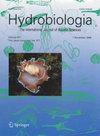韦拉克鲁斯珊瑚礁系统国家公园岛屿上的鸟类群落
IF 0.3
4区 生物学
Q4 MARINE & FRESHWATER BIOLOGY
引用次数: 0
摘要
背景。在维拉克鲁萨诺国家公园(PNSAV)进行的鸟类研究之前报告说,48%的鸟类是冬季候鸟,52%是留鸟。然而,其岛屿上鸟类群落的结构尚未被分析。目标。分析了舍利西奥斯岛、Verde岛、Salmedina岛、Polo岛、de Enmedio岛和Santiaguillo岛的鸟类群落结构。方法。从2021年4月至2022年4月,在每个岛屿进行了六次鸟类普查。利用Shannon指数、Margalef指数和Simpson指数测定了物种丰富度、丰度和α多样性。此外,还将鸟类分为海洋、水生或沿海、鹰和陆生,并计算了每个岛屿上这些类群的种数和最大值之和。最后,利用所有这些信息,分析了各岛屿鸟类群落的构象及其在整个研究年度的多样性变化。结果。De Enmedio岛的多样性值最高(2021年4月和10月)。10月,舍利西奥斯岛、佛得岛和圣亚吉略岛的多样性值最高。Salmedina和Polo在2021年7月和2022年1月的多样性最高;在这两个岛上只观察到海鸟和沿海鸟;在其他岛屿上,陆生物种占主导地位。在波罗岛上,尽管岛屿面积很小,但海鸟数量却非常丰富。结论。海鸟休息和繁殖的栖息地似乎受到了巨大的人为压力。需要有更多关于这些岛屿的信息,而产生这些信息与PNSAV的综合管理有关本文章由计算机程序翻译,如有差异,请以英文原文为准。
Bird communities of the Veracruz Reef System National Park islands
Background. Bird studies in the Sistema Arrecifal Veracruzano National Park (PNSAV) have reported pre-viously that 48 % of the birds are winter migrants and 52 % are residents. However, the structure of the bird communities of its islands has yet to be previously analyzed. Objectives. To analyze the bird communities’ structure of Sacrificios, Verde, Salmedina, Polo, de Enmedio, and Santiaguillo islands. Methods. From April 2021 to April 2022, six bird censuses were conducted on each island. With the data obtained, species rich-ness, abundance, and alpha diversity using the Shannon, Margalef, and Simpson indices, were determined. Additionally, birds were classified into marine, aquatic or coastal, hawks, and terrestrial, and the number of species and the sum of maxima of these groups were calculated for each island. Finally, with all the informa-tion, the conformation of each island’s bird communities and their diversity variations throughout the study year were analyzed. Results. De Enmedio Island had the highest diversity values (April and October 2021). October had the highest diversity values for Sacrificios, Verde, and Santiaguillo islands. Salmedina and Polo showed the highest diversity in July 2021 and January 2022; only marine and coastal birds were observed on these two islands; in the other islands, terrestrial species predominated. On Polo Island, marine birds were highly abundant despite the island’s small size. Conclusions. There appears to be great anthropogenic pressure on seabirds’ resting and breeding habitats. There needs to be more information about the islands, and generating it is relevant for the integrated management of the PNSAV
求助全文
通过发布文献求助,成功后即可免费获取论文全文。
去求助
来源期刊

Hidrobiologica
生物-海洋与淡水生物学
CiteScore
0.40
自引率
0.00%
发文量
8
审稿时长
>12 weeks
期刊介绍:
HIDROBIOLÓGICA es una publicación cuatrimestral que difunde trabajos originales e inéditos de investigación o revisión, sobre temas relacionados con los organismos y la hidrología de los ambientes acuáticos, dulces y marinos y va dirigida a investigadores de todo el mundo, interesados en las diversas disciplinas que incluye la Hidrobiología , así como a alumnos de posgrados y licenciaturas relacionados con la biología, ecología, taxonomía, filogenia y evolución de organismos acuáticos, e hidrología y oceanografía de ambientes s dulceacuícolas y marinos.
 求助内容:
求助内容: 应助结果提醒方式:
应助结果提醒方式:


